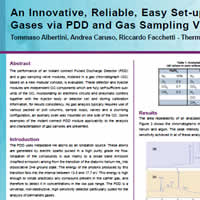Resumo do Pôster:
1. Introduction
The PDD utilizes a pulsed DC discharge in helium as an ionization source. The PDD is a universal, non-destructive, high sensitivity detector particularly suited for the analysis of permanent gases. These compounds can be detected up to the low ppb with an excellent linearity range. A criticality in the analysis of gases is the introduction of the sample into the gas chromatographic system. The most reliable and wide-spread technique to inject a gas or a vapour is the injection through a sampling valve.
In this work the benefits of the adoption of a modular gas chromatograph that offers a flexible and easily installable solution for gases analysis will be presented. Both the PDD detector and the gas sampling valve are comprised into two, user-installable, fully integrated modules that include the detector body or the sampling valve body along with the pneumatic circuits and the electronics necessary for their operation and control.
This modular design allows a new level of instrument flexibility, where inlets and/or detectors selection is based on the application in use, and can be changed in a matter of few minutes by the operator when a new analytical need or application requires different injector and/or detectors without affecting the analytical performances. This work will discuss the performance of such a system showing the data obtained on gas samples analysis.
Moreover, without adding further hardware complexity, the gas sampling valve module chosen can be easily set to backflush to vent the undesired part of samples, therefore offering an easy and integrated set-up for more complex analysis, without affecting the PDD response. Data showing performance of this solution will be illustrated and discussed.
2. Purpose
Introduce a novel, innovative PDD detector module and show some examples of its applicability to the analysis and characterization of gas samples.
3. Method
Gas analysis by gas chromatography typically requires use of various packed or plot columns to effectively separate all the compounds of interest. Sample injection is performed by a valve-and loop injector and the path of the analyte is controlled by switching valves in a timebased way to send the different portions of the effluent carrier gas to the different columns, to the detector, or to the vent. All of the examples in this paper use a gas chromatograph equipped with an instant connect PDD module and an auxiliary oven. Valve and column configurations differ from one example to the other. Sample acquisition, system control and valve switching is handled by the same chromatography data system software. The applicability of the pulsed discharge ionization detector was exemplified by the analysis of impurities in bulk gases, breathing oxygen, xenon and krypton gases.
4. Results and Discussion
Analysis of N2, O2, CO2, H2, CO, CH4 impurities were done in He/N2 mixes, He, and Ar. The repeatability of the areas of all analysed samples showed high sensitivity and a RSD below 1.5%.
The analysis of the impurities CH4, CO, CO2, N2O, C2H6, C2H4, C2H2 in breathing oxygen showed linearity plots with R2 greater than 0.999. The repeatability of the areas of all samples analyzed showed a RSD lower than 1.5% and minimum detectable quantities < 1 pg. Figure 1 shows the chromatogram of the xenon analysis.
5. Conclusion
The PDD is an excellent detector for the characterization of gas samples due to its high sensitivity, allowing for the detection of trace impurities. Combined with different column and valve configurations, this detector is applicable to a vast range of analyses. In the gas chromatograph used, the instant connect PDD module installation requires no modifications to the GC frame or plumbing.
The modular innovative approach to GC instrumentation design allows easy configuration change and/or upgrade, and easily match instrument configuration to application needs. Particularly important are the design aspects of the injector and detector modules, their couplings with the high temperature column oven, the miniaturization of pneumatics circuits, and electrical-mechanical components. |

